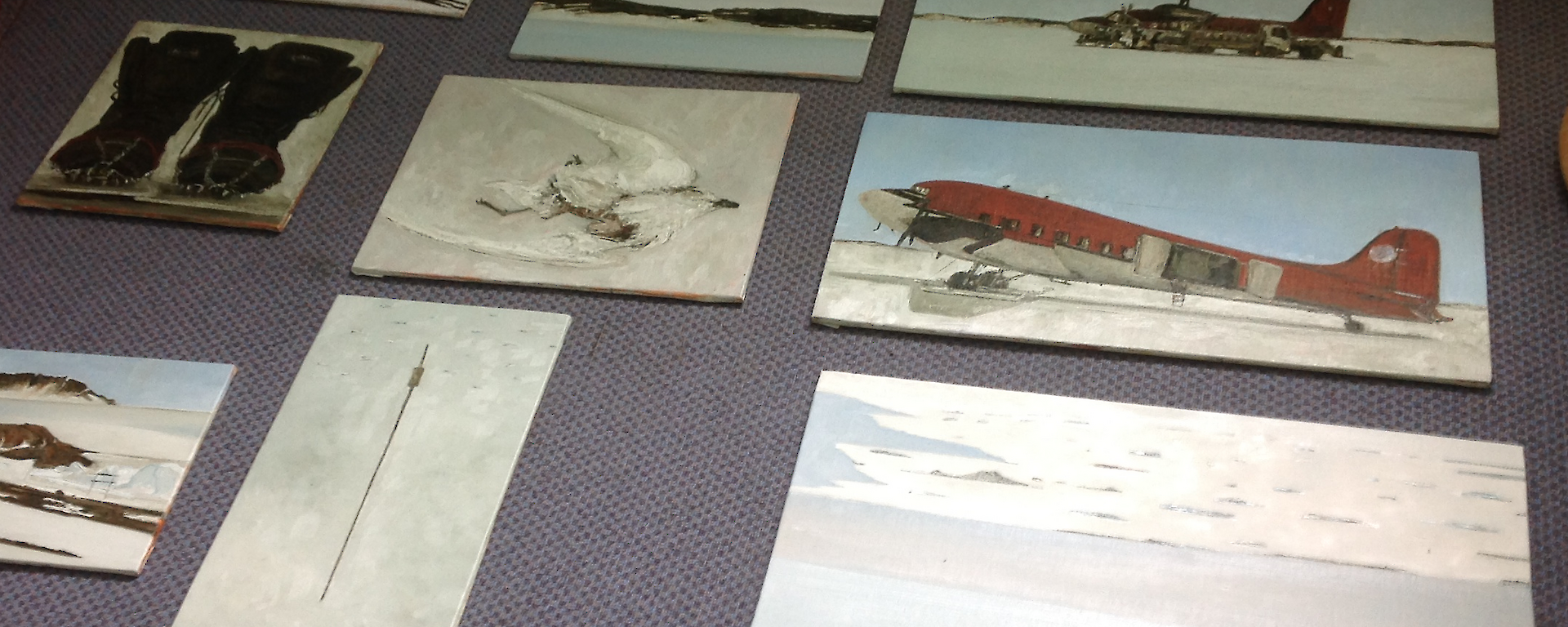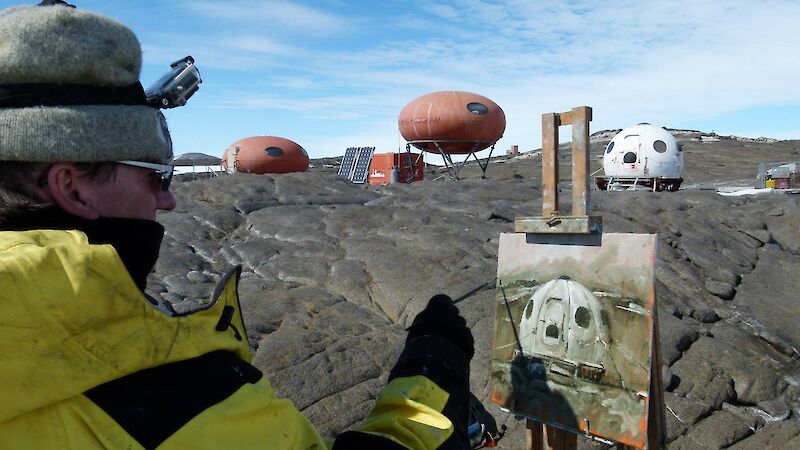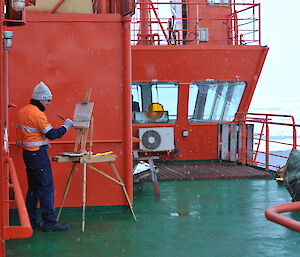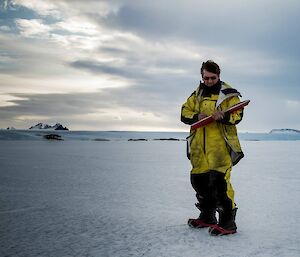It’s April 2014. The Boeing 777 flies over Malaysia then banks, proceeding along the Malacca Strait. As the plane turns again, I can’t help thinking of the missing Malaysian Airlines plane, MH370, the one presumably lost thousands of kilometres further south in the Indian Ocean. Press reports described the part of the Indian Ocean where it might be as one of the remotest places on earth.
If the Indian Ocean west of Perth is remote, then the Australian Antarctic station at Mawson, thousands of kilometres further south, is beyond Whoop Whoop; another world, where normality is turned on its head. Antarctica, the driest continent on earth, holds 70% of the earth’s fresh water. Its bright light and white sheets of ice are a photographer’s dream, yet for six months of the year it is continually dark; a continent full of danger and contradictions. It is several months since my return from Antarctica, not long enough to properly comprehend my voyage, but I am already aware that it is a significant point in my life as an artist.
Friends ask ‘What was the most difficult thing about Antarctica?’ and I reply, ‘the decision to go’. There is also a difficulty in returning to normal life after a journey that had so many exciting adventures that heightened one’s senses. My Guardian blogs record my visits to the nunataks at Rumdoodle, to Auster Rookery and the Adélie penguins at Béchervaise Island, viewing icebergs from Mount Henderson, and staring down beautiful blue crevasses.
My incredible journey began in Hobart in October 2013, in a collegiate atmosphere with 90 others that took me across the Southern Ocean on the icebreaker Aurora Australis. The ocean voyage had adventure and excitement from the beginning, when we attempted to outrun a storm crossing the Great Australian Bight, only to turn into some wild weather further south that sent the ship rocking and rolling, with sea-spray smattering the windows of the Bridge and sending many scurrying to their bunks. This sea voyage, estimated to be around 11 days, turned into a three-week epic, with much of it spent icebreaking. The effort delivered a piercing audio below deck, in my ‘studio’, as the ice scratched at the steel hull, and on more than one occasion I stopped painting thinking that the ship had been ripped open.
On arrival in Antarctica a small group of us were helicoptered off the Aurora Australis, over Iceberg Alley and onto the ski-way at Davis, where a DC3 flew us across the Amery Ice Shelf to Mawson. After three weeks on-board, I had become used to company in this isolating landscape. How could you not be sociable in the shared cabins and the close quarters of the ship, with life revolving around the wonderful galley; although after several weeks it felt like being locked in a cafeteria!
As my journey progressed, the number of people around me diminished until, at the end, I was the only one left on a plane that flew back over Bass Strait to Melbourne. It seems now like a nice metaphor that explains how, despite the practical proximity of others, the journey to the remotest part of this earth is a journey from which, by necessity, one returns alone, with your own thoughts and memories. After all, we all had come from diverse backgrounds and professions, with different goals and missions to complete in this hostile environment, where one has to confront oneself both physically and mentally. It is almost like a physical embodiment of panning back from oneself, exemplified when the DC3 banked over the Aurora Australis to reveal that my entire world of three weeks — that enormous and imposing ship — was nothing more than a tiny red speck on a vast sea of white.
I have no problems admitting I found my experience confronting and challenging; 55 paintings in nine weeks and five essays published whilst working in such a difficult environment broke me down day by day. Physically and mentally the environment took its toll. By the time we flew back to Davis from Mawson, after several weeks of work, I was in need of a rest. However that was to prove impossible.
The first evening I was billeted in the communications building and was within earshot when the communications officer uttered words that felt like fingernails drawing down a blackboard; ‘whiteout, helicopter down, injuries’! The helicopter had gone down in a crevasse field on what was termed The Loose Tooth, an appendage of the continent waiting to be an iceberg. It was the same helicopter and pilot who had flown me off the ship a few weeks earlier and the prognosis was not good for our colleagues. The weather had closed in and immediate rescue was impossible. We were told they could be stuck there for a week or more.
The stress and uncertainty that accompanied the accident made working impossible. Over the next few days the anxiety and fear for our colleagues was palpable and those endless days stretched one’s mental resources as we waited for the weather to break. It was excruciating. I could only imagine how it felt for those trapped out on the ice.
We were informed that with the loss of the helicopter the normal flying program would be cancelled and that many of the scientific projects would also be cut short. This meant a small group of us would be on the first and last available DC3 flight back to Casey, after the injured had been retrieved and evacuated. Fortunately, after a couple of days, the weather brightened long enough for the rescue to succeed. A few days later a Twin Otter flew us from the sea ice up to Whoop Whoop, another ski-way, to await the return of the DC3, which duly arrived to fly us out.
By the time the five-hour flight to Casey ended I was exhausted. Because of luggage restrictions I had left a significant amount of my art materials back at Davis, so even if I had the energy to work, I simply did not have the material to keep painting. Instead, I flew back to Hobart with a small group of others on the A319 to spend Christmas with my family. When the crew offered me a lift to Melbourne, I gratefully accepted and had the rare experience of being the only passenger on a commercial airline. Returning alone, after a visit to the most isolated place on earth, felt like an apt end to my journey.
Whilst in Antarctica and after the helicopter crash, I felt that our presence there might be an extravagance, a far too hostile environment for scientists and others to risk their lives to collect esoteric data. However, a few weeks after my return, the press announced that evidence of gravitational waves from the Big Bang had been observed that confirmed Einstein’s theory of relativity. The information had come from a microwave-sensitive telescope in Antarctica that had relied on the dryness and darkness to be able to collect the data, in an environment where time and space behave quite differently to what we are used to. It made me realise just how special this frozen cap is to our ability to understand our world, our universe, and the potential that there might be others. It seems fitting that the evidence for Relativity was collected from this icy world that man had only just begun to explore when the Zurich patent clerk with a wayward haircut put forward his incredible hypothesis.
See more of John Kelly’s work at John Kelly Artist.
John Kelly
Australian Antarctic Arts Fellow 2013–14





